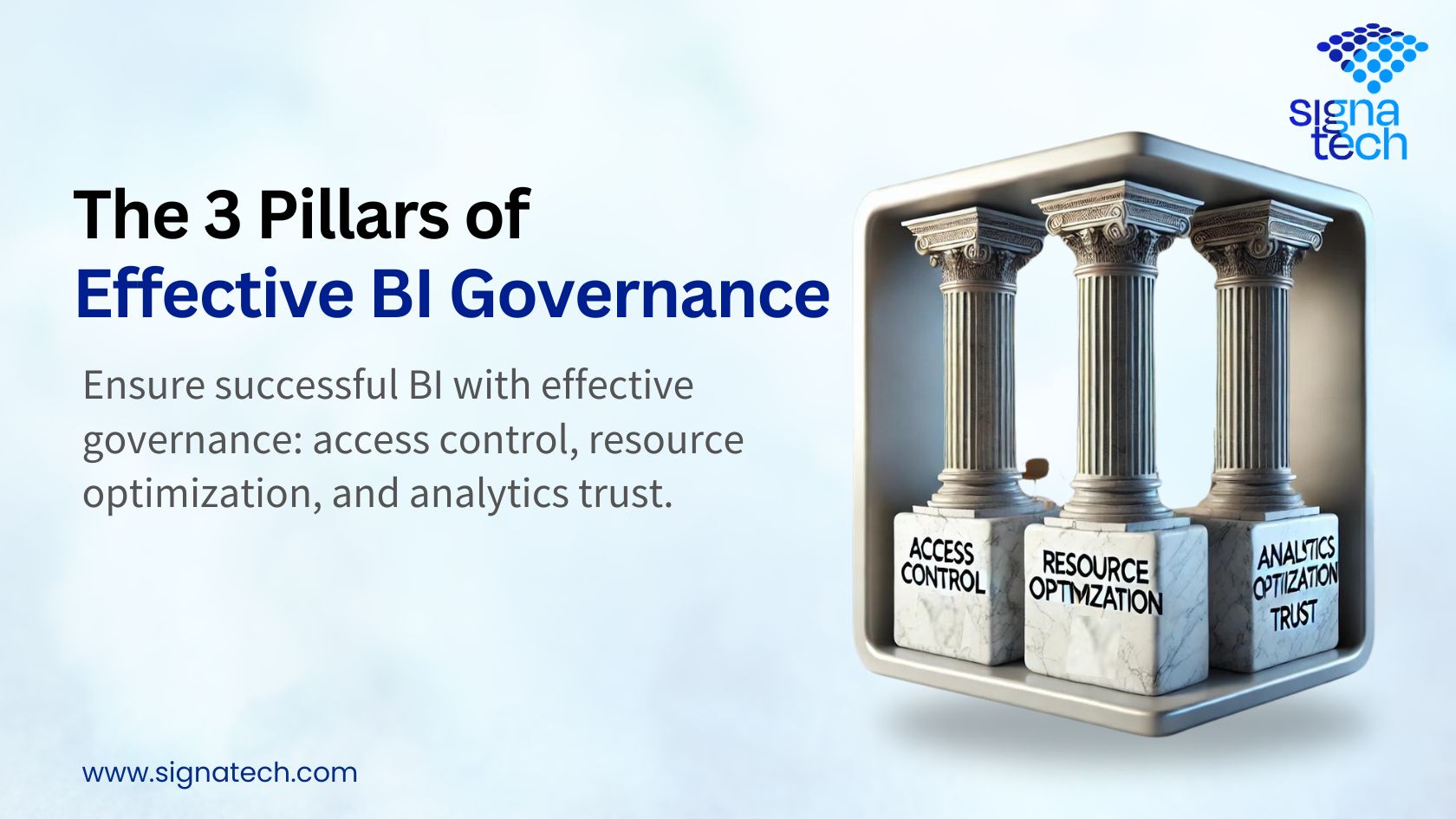In a successful enterprise Business Intelligence (BI) deployment, there is a requirement for a governance layer over the data being captured and the analytics being delivered. Without effective BI governance, the erosion of user trust in the analytics or the BI team complicates proving a solid ROI on BI investments. This blog gives the basics of implementing BI Governance across an organization.
Two Sides to BI Governance
Data governance is a predominant component of most organizational data strategies, and rightfully so; it is only one side of the coin. Business users consume information through BI tools rather than raw data. Therefore, any good governance plan will find a way to combine data governance and BI governance, such that the content put in front of end users is equally important as the data behind the content.
Evaluate Your BI Governance Strategy
Effective BI governance involves locking down those BI reports and dashboards. Use the following 5 principles to evaluate the sufficiency of your BI governance strategy:
- Content is secure and accessible.
- BI platforms are more transparent.
- Consumers have trust in BI.
- BI tools are broadly and effectively used
- BI teams are proactive rather than reactive.
The BI Governance Challenge
The difficulty in governance within the BI environment arises from the fact that the tools and content are prolific, resulting in many dashboards and reports. All these tools have varying capabilities for governance aspects like discoverability, certification, and usage tracking. An effective governance strategy thus demands a holistic approach in bringing all the BI assets together under a single governed framework.
Three Pillars of Effective BI Governance
Access Control
Balancing security and discoverability is key in a governed environment. Security helps protect sensitive information, while discoverability allows users to find the right content and request access.
- User Roles & Access Control: Define user roles based on personas and align content types to support their journey across different BI tools. Map how each persona can interact with the content.
- Content accessibility: Organize content consistently, make content accessible from one portal, tag, and document content, certify for trust, and make it discoverable without compromising security.
Resource optimization – governing a well-governed environment
Optimizing resources in a well-governed environment entails the following:
- BI Team: Proactively allocate BI team efforts optimally and thoughtfully across projects to maximize business value rather than reactively allocating resources.
- BI Content: Manage the lifecycle of BI content to avoid clutter and assure that users access only relevant content.
- BI Licenses: Regularly review the utilization of BI tool licenses to justify spending and inform future budget allocations.
The ROI of Resource Optimization
Create a good ROI for BI spending by optimizing the BI team, content, and licenses through:
- Usage tracking to understand report and dashboard usefulness.
- Automated promotion or deprecation of content as a result of its usage.
- License tracking and processes associated with provisioning, de-provisioning, and upgrading licenses.
Analytics Trust
Trust is an essential part of the engagement of BI. There will always be issues with the data and BI processes, but more communication is needed to maintain trust. To sustain trust:
- Automate data quality checks to flag issues before the data becomes published.
- Ensure good communication lines are implemented to keep users informed of issues. This will help in providing notifications to affected users only.
Strategies for Implementing Effective BI Governance
- Create clarity in governance policies: Define clear governance policies: How will data and analytics be managed and accessed? Update these policies periodically to reflect the variation of business needs and regulatory requirements.
- Develop Governance Framework: Develop an effective BI governance framework that defines the roles and responsibilities of the stakeholders: the data stewards, BI developers, and business users. Define processes for data validation, report certification, and issue resolution.
- Implement Robust Security Measures: Deploy strong security to guard sensitive data against unauthorized access. Implement encryption, access controls, and authentication mechanisms, followed by regular security audits and vulnerability assessments.
- Make data literacy part of the conversation by educating business users about data governance and training them on using BI tools for small business effectively. Train users through classroom training, workshops, and documentation to clearly understand policies related to data so that informed decisions based on accurate insights can be made.
- Lead by Collaboration: Foster collaboration between IT and business user teams with an orientation towards aligning BI initiatives with business goals. Regular communication can identify data needs and problems and work towards improving the BI environment.
The BI Governance Lifecycle
BI governance is a process that always continues. BI Portal: Metric Insights Operations: This allows:
- Tracking of continuous usage of the BI content at all touchpoints.
- Content development and deployment are guided by already existing content usage that ensures security besides fostering discoverability.
- We are measuring the level of engagement along with various user types over time.
- Promote or purge content to tidy up the BI environment.
- Know how users use content around BI tool licensing and realize maximum ROI through proper license management.
An organization needs to have an Effective BI governance strategy to allow them to reap benefits from their investment in BI. An organization can build a governed environment that stresses security, discoverability, and user engagement, focusing on access control, resource optimization, and analytics trust. BI governance through the implementation of clear policies, collaboration, and data literacy leads to effective BI governance. With this in place, organizations can rest assured of meeting their long-term BI initiative goals, enhancing better decision-making and, therefore, getting maximum ROI
Signa Tech specializes in business intelligence consulting services to help implement effective BI governance strategies within your organization. Our expertise guarantees that your BI environment is secure, efficient, and trusted by users, maximizing the value of your BI investments.
